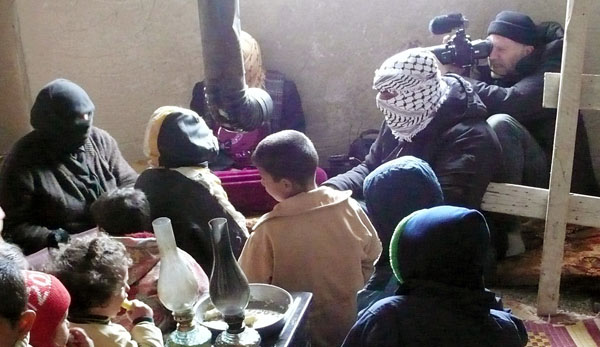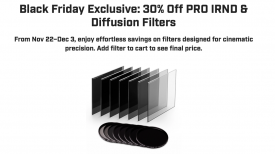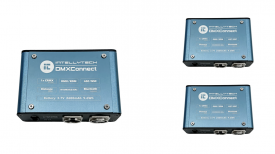Guest post by Christian Parkinson of imagejunkies.com

In March I was able to watch the BBC Panorama film called ‘Homs: Journey into hell’ fronted by Reporter Paul Wood and shot by top BBC Cameraman Fred Scott. It was an amazingly strong and powerful piece of film making that also stood out for its use of Video DSLRs to tell a story where a big shoulder mounted camera would have been impractical. If you want to watch the piece then here is the link (sadly for UK viewers only). Fred is an old friend of mine and agreed to do a short interview for www.imagejunkies.com on the kit that he used and how and why he did so:
So what kit did you take with you into Syria?
The main camcorder is a Canon 5D mkII equipped with:
Zacuto Z-finder loupe viewfinder.
Sennheiser MKE-400 top mic.
Hawk-Woods Hot-Block with 1m wire to power the camera with DV batteries if I need to.
Vintage Nikkor 20-35mm and 80-200mm f2.8 lenses, “de-clicked” aperture rings,
Novoflex Nikkor to Canon adapter rings.
Genus variable ND filter.
Marantz audio recorder.
As a backup I take a Sony NX70 camcorder. It is weather resistant and fairly tough. It has a detachable XLR audio unit that lets me use the wireless receivers that we would normally use with bigger rigs.
This stuff fits in a Camelbak and waist pouch. I can shoot for days like that without needing a charge.
What made you choose this kit? Why did you decide on the 5D as opposed to say a 7D or even an EX1?
I chose the 5D because I could get a very shallow depth of field. This helps a lot when you have to interview masked or otherwise disguised people in nondescript rooms, in very low light. You can more effectively guide the viewers eye to what you think is most important in a frame.
How were the Nikkor lenses?
I have had these lenses for 15 years, gathering dust lately, till the DSLR’s arrived – and a second life for the lenses. They don’t have a great touch for motion picture use, especially the 80-200mm which is very clunky pulling focus. But they are very tough. And if you use them in terrible climates – natural or man made – they are comparatively cheap to replace.
I’m assuming they don’t have image stabilisation, was that a problem?
I hold very still. And I kind of like the juddery codec shutter issue – whatever it is that causes that. And there is always a pillow in Syria for support.
A note and possible warning to DSLR users in very wet conditions: using older lenses of any make with a 5D/7D might save you from a total breakdown. Mark McCauley (Another top freelance Cameraman who works regularly with the BBC) and I suffered on Kilimanjaro when both a 5D and 7D stopped working because of wet. The lenses were electronic Canon EOS. Our understanding of why we could not get the cameras working again was because the damp lenses were electronically telling the easier to dry-out camera that they were very unhappy and unavailable for pictures till dry. An older lens will simply go on and make (foggy) pictures for you. We finished the shoot with a Sony A1.
Did you encounter any other problems?
Not great sound. That’s a well known problem. But we had good proximity with incoming rounds.
Did you have a laptop and were you having to encode and sync footage as you went?
Yes. Pluraleyes was great. This plug-in managed to sync an interview where the camera’s top mic was not switched on as the crucial guide track, but the very faintest of voice was present buried under a pile of hiss from the camera’s built-in mic.
We had time so I also did some mini grades in FCP Colour Corrector. I deliberately underexposed in low light to reduce video noise, then bumped the levels back up in the timeline.
Did Paul Wood (Reporter) understand what you were doing and did you have any problems explaining the extra time that is always needed with DSLR shooting?
We didn’t really have time issues when filming. It was a mix of being confident with the camera and Paul always ready with his Marantz Audio recorder. We made a few audio blunders both individually and together – as things always go. With the edit? That is slow. Any work flow suggestions? I Log and Transfer into FCP using the 422 LT option to knock the HD down a bit for what will eventually be a DV25 Inmarsat (BGAN) transmission to London. I edit on a 422 LT timeline, then down convert. It can be painfully slow. Especially if you have made any picture corrections or applied filters. The CF card readers I use to Log and Transfer are either a Lexar firewire 800 reader or a Sonnet Thunderbolt adapter with a CF express card plugged into it. Curiously, the old Lexar 800 seems faster than the Sonnet Thunderbolt in all its awesome-ness.
Is there anything you would do differently next time?
I am taking a Canon C300 and the same lenses next time. But maybe there shouldn’t be a next time. That would be different.
This guest post was originally published by Christian on his blog www.imagejunkies.com and is reproduced with kind permission.






